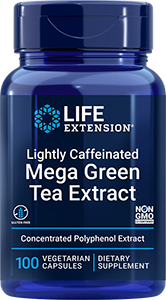- Science & Research
- Science News
- Newsletter
- 2006
- December 30

Newsletter
Newsletter
Green tea helps prevent stroke induced brain damage
 | ||||||||||||||||||||||||||||||
| ||||||||||||||||||||||||||||||
| ||||||||||||||||||||||||||||||
| Life Extension Update Exclusive Green tea helps prevent stroke-induced brain damage A study conducted by Weihai Ying, PhD, reported at the 2006 annual meeting of the American Society for Neurosciences, found that intranasal administration of a green tea compound protected the brains of rats in whom stroke was induced. The compound, gallotannin, was administered nasally up to three hours after circulation was restored. The study is the first to compare intranasal and intravenous drug delivery in an animal model of stroke. Dr Ying, who is an assistant adjunct professor of neurology at the University of California, San Francisco, previously discovered that by inhibiting the activity of the enzyme PARG, gallotannin decreased cell death during ischemia, a condition which occurs when there is a lack of blood flow during stroke or similar events. When Dr Ying administered the compound to rats in the current study, he found a similar reduction in brain cell death following ischemia, a well as an ability of gallotannin to block an effect associated with PARP-1, an enzyme related to PARG, which, when activated following ischemia, results in the movement of apoptosis inducing factor (AIF) from the mitochondrion into the nucleus of the cell, causing its death. Interestingly, intravenous administration of gallotannin offered no protection against the activity of PARG or AIF. "This finding suggests that the intranasal method could be more advantageous than IV for delivering a drug for treating central nervous system diseases. It may get much more of the drug past the blood-brain barrier,” Dr Ying stated. In other recent research, published in the January 1, 2007 issue of the journal Frontiers in Bioscience, Dr Ying reported that nicotinamide adenine dinucelotide (NAD+), a compound produced by every cell in the body, also protects against stroke-induced ischemia when intranasally administered. Rats given NAD+ had a 70 to 86 percent reduction in brain cell death after blood flow restoration compared with animals that did not receive the compound. The study was the first to investigate NAD+ as a treatment for brain injury and the first to demonstrate its effectiveness in an animal model, according to Dr Ying. "The protective effect is profound,” Dr Ying observed. Because both compounds demonstrated a protective benefit hours after the onset of ischemia, they may prove to be useful for treating brain injury among humans who frequently do not receive essential treatment during the critical sixty minutes following injury. Stroke and cerebrovascular disease There are two main kinds of stroke. The most common, an ischemic stroke, occurs when an artery in the brain is blocked by a blood clot, usually because of atherosclerosis (the deposition of plaque on the inside of artery walls). Alternatively, a hemorrhagic stroke can occur when a portion of the arterial wall weakens and bursts. A stroke is a serious medical emergency that requires immediate medical attention. Time is a critical factor in stroke management: some experts now refer to strokes as “brain attacks” to stress the need for emergency treatment. Most of the damage from a stroke occurs within 24 hours following the event, so it is crucial that people get adequate treatment as fast as possible to reestablish blood flow and limit the damage. If stroke-like symptoms last for more than 10 to 15 minutes or worsen, call 911 without delay even if it is unclear whether a stroke has occurred (NINDS 2005). Green tea catechins, which are rich in flavonoids, possess powerful antioxidant properties that have been studied in the context of limiting damage due to ischemic stroke. Animal studies have shown that green tea extract limits the size of stroke lesions in a dose-dependent manner when administered immediately after an ischemic episode, leading researchers to suggest that green tea may have promise in the acute treatment of ischemic stroke (Suzuki M et al 2004; Lee SY et al 2003). Another study found that animals that had a high intake of green tea experienced less cerebral damage after a stroke than did their counterparts who weren’t consuming green tea (Hong JT et al 2001). https://www.lifeextension.com/protocols/heart_circulatory/stroke_cerebrovascular_disease_01.htm Featured Products
Life Extension magazine Super Sale Edition Winter 2006/2007 The Life Extension Foundation introduced green tea extract as a supplement in 1993 based on epidemiological studies showing that people who consumed green tea had lower incidences of common degenerative problems. Over the past 13 years, an enormous volume of positive studies has been published about the health benefits of green tea. Scientists have looked at the active “polyphenol” constituents of green tea and have found that they possess remarkable biological activities that include inhibiting LDL oxidation and neuronal peroxidation, while maintaining healthy DNA structure. The new Life Extension Mix contains 325 mg of a decaffeinated green tea extract that is standardized to provide 98% of the active polyphenols that scientists attribute to green tea’s multiple health benefits. https://www.lifeextension.com/magazine/mag2006/ss2006_report_lemix_01.htm | ||||||||||||||||||||||||||||||
If you have questions or comments concerning this issue or past issues of Life Extension Update, send them to ddye@lifeextension.com or call 1-800-678-8989. Life Extension would like to take this opportunity to wish every one of you a safe and healthy 2007! For longer life,  Dayna Dye Sign up for Life Extension Update at https://mycart.lifeextension.com/Memberships/NewsSubscription.aspx Help spread the good news about living longer and healthier. Forward this email to a friend! View previous issues of Life Extension Update in the Newsletter Archive. | ||||||||||||||||||||||||||||||
The latest news on aging, nutrition, and vitamins
Lab
Testing
How Life Extension lab testing works


